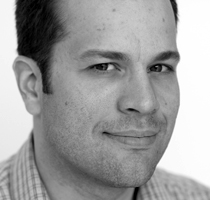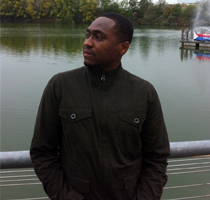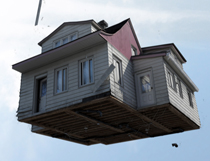P.I.: It is interesting that you mention Le Faux Movement, which i think is a fantastic piece of work. In the same vein, I’m equally charmed by the multi-mirror installation Poursuivre le hors-champ [Continuing off-field]. The idea of a mirror that moves and an image constantly changing in front of it is enthralling; this is given more fizz with your explanation of the process as “showing what is in the dead angles”. I observe that the large mirror is broken up in small squared shapes; just wondered if there might be the same variety of reflection if the mirror is split up in different shapes – say triangles or even rhombi, what do you think?
G.B.: With the intention of working with the mundane and everyday, I wanted to work with probably the most common images: one that is reflected in a mirror. Most of the time the mirrors around us are square, allowing me to work in a very simple grid. Seeing one’s reflection in a mirror is probably the most common experience there is. How many times do we look in the mirror each day? When we look in a mirror, it is first and foremost one’s own image that is important to us. This double reality has something fascinating and mesmerizing. It confirms, in a sense, that we exist because, really, the idea that the ghost who walks in front of a mirror does not see his own reflection is well known. When you begin to dwell and reflect on this phenomenon, something escapes us and goes beyond us, as if there was magic in this. It is the habit of daily life that makes this phenomenon quite banal. This project seeks to bypass the common experience. It formats the idea of making the image elusive, difficult to define. It adds complexity to identify and reconstruct the image. In addition, the project also gives importance to what we do not care about when we look in a mirror, that is to say, our environment, the place where we are. The installation is based on an ingenious mechanism that allows the work to both put into place distort the image and the perspective of its collapse. The movement of the mirrors seems completely random. Some mirrors are moving smoothly and all of a sudden, very jerky movements occur. The mirror creates spatial complexity in the small gallery and the image that the viewer receives becomes elusive. Clashing perspectives and scales of magnitude are also confounded. The viewer is faced with a huge image, strangely familiar, but constantly changing, demanding his continual reassessment. The installation tries to unveil what is in the blind spots, to capture what is outside the framework, to ultimately generate a new vision of what escapes us, in short, a new definition of off-screen. I responded with this project, to a challenge I gave myself – which is to make a picture without a photograph. In this regard, Marie-Eve Charron, in her article in Le Devoir on March 8, 2008, said:
Generated by the reflection, the work depends on the environment, but deviates from it by developing another place, imaginary and ethereal, made out of unexpected fields. […] It is the image under construction and the perception of it that seems to have interested the artist. […] The device certainly accentuates the gap between self, body and what is seen, but it also exploits the idea of lapse of time. The images are made and unmade in time, confronting the viewer to experience and interpret that what he is seeing, what he saw and what he anticipates to see in the future. All this from his unique presence.
This project speaks of the image without using photography. Once the device is in place, the installation becomes a machine that has the ability to generate constantly renewing images. If we fix the installation with the photographic medium, including playing with the exposure time, we get a freeze frame that generates new representations of movement and the distortions that follow.
P.I.: Your last sentence in response to my question above provides the cue for the next question. In this age of digital technology where manipulation of images is increasingly rife, distortion of prints is still a favoured technique in your work, I’m curious to know how you ensure your photography and other initiatives remain bound in art, i.e. embody an artistic index?
G.B.: I think my work managed to stand out not only because of the seductiveness of my images, but also through the questions and queries they offer. I have a conceptual approach to photography that in particular reflects the status of the image. So even if I am interested in manipulating the image and its forms of seduction, my work is not based solely on this aspect. My goal is not to take very clean, very slick photographs as seen occasionally in advertising. For me, the poetic impression is very important as well as the mysterious, unknown quality that goes beyond the viewer. It is always interesting that the audience asks questions. It keeps them in front of your work for longer.
P.I.: “Le Tournis” is a six-minute looped video installation showing an interior space (your studio) from a central viewing point. The camera continually revolves on itself, scanning the space at high speed. Does your video work mesh with other mediums especially with the peripatetic nature of your photography?
G.B.: In fact, for all my Chutes (Falls) projects, I filmed with an HD camera and I take the photographs with another camera at the same time. For some projects, I use both still images and moving images depending on what project. The best example is the production of works Le Faux movement (The False Movement). I used an 8 meters long photograph and for Le Tournis (The Turn), I chose a 6-minute video. Both projects are generated by the same event. What fascinates me is that the moving image and the fixed image have their respective characteristics, as well as their different ways of projecting the composite image. What we see, observing the photograph is the gap between photography and video, at the aesthetic level, even if it is documenting the same event. Photography is very appealing when it is pictorially rich. First, it uses the technique of light /dark and establishes the contrast between the bright spot where the impact takes place and the back of the room away from the source. Secondly, it combines the fuzzy moving shards of mirrors and the blur caused by such a small depth of field. These combinations provide stunning visual effects. So in terms of depth of field, a burst of mirror has very sharp edges. The sharp edges of the glass where the light is refracted are the only indication that leads back to the materiality of the object. Meanwhile, the blur affects only the vague outline visible from the mirror, that is to say, its thickness, since what is reflected in the mirror does not move.
P.I.: Are there more exhibitions lined up this year. What is your next move?
G.B.: I presented a solo exhibition at Galerie Graff in May, and participated in a group exhibition in Mexico City this summer. So I am now going back to my studio to do some intensive work and to continue my research. Otherwise, in 2012, I have a residency and an exhibition at the Centre Sagamie in Alma, Quebec. There may be a project exhibition at Nettie Horn London, but everything needs to be confirmed.
P.I.: It’s taken a while to catch up with you for this exchange Gwenaël. Many thanks for being generous with your time and my best wishes to you. Hopefully we’ll meet up soon.
G.B.: Thank you very much Patrick. See you soon.
















No Comments so far ↓
There are no comments yet...Kick things off by filling out the form below.